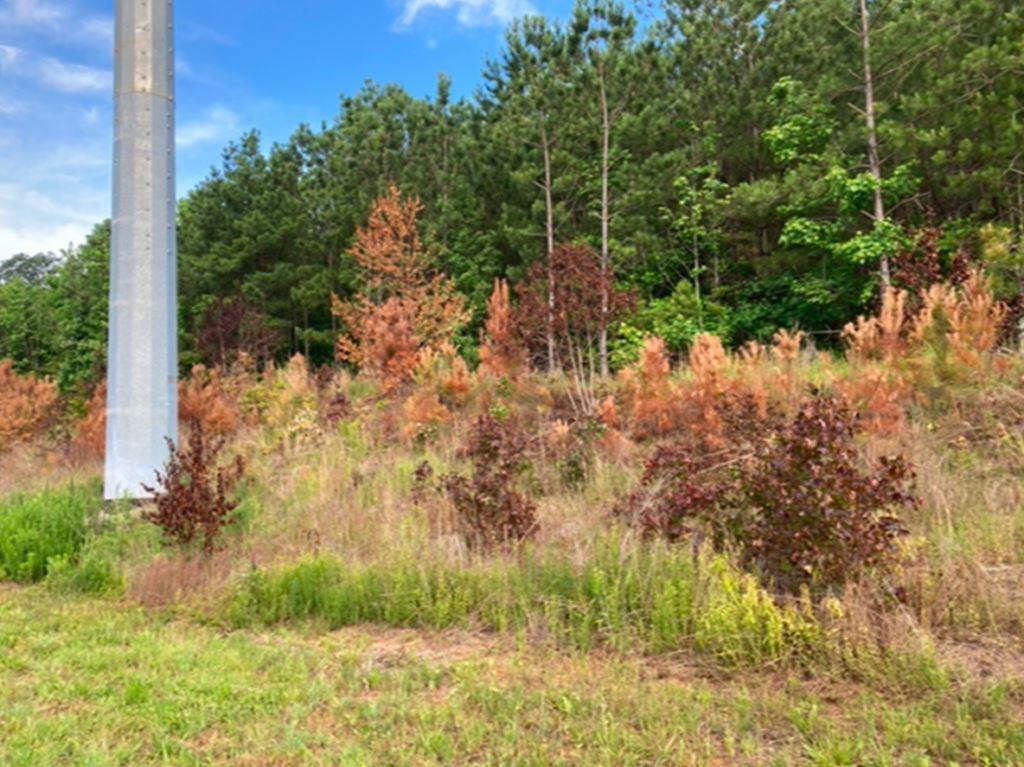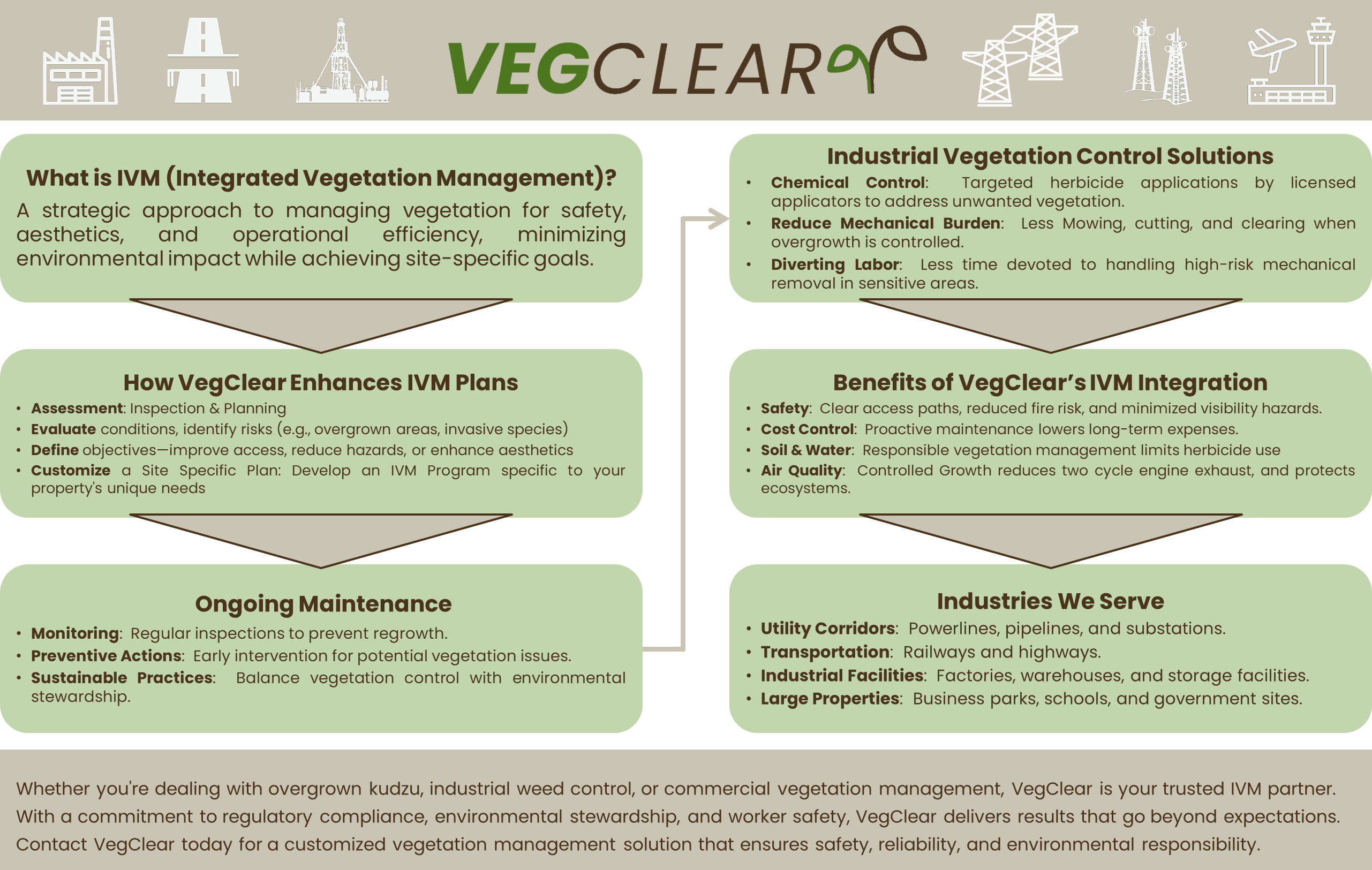
Effective Vegetation Management and Commercial Weed Control Services Are Part of a Holistic IVM Approach
What is Integrated Vegetation Management (I.V.M.)?
Get Clear Answers About Integrated Vegetation Management (IVM)
Frequently Asked Questions About IVM
Learn how Integrated Vegetation Management works, why it’s the industry standard for industrial weed control, and what makes VegClear a trusted IVM provider across Georgia, South Carolina, and the Southeast. This FAQ covers key details about herbicide use, program benefits, site types, and how to get started; so you can make informed decisions about long-term vegetation control for your property.
What exactly is Integrated Vegetation Management (IVM)?
Integrated Vegetation Management is a strategic, long-term approach to controlling unwanted plant growth in industrial, utility, and municipal settings. Rather than relying on a single method like spraying or mowing, IVM uses a combination of tools; targeted herbicide application, mechanical clearing, cultural practices, and site monitoring; to deliver efficient, compliant, and environmentally responsible results. It’s about much more than spraying weeds, it encompasses responsibly managing landscapes long term.
How is IVM different from conventional weed control?
Conventional weed control often means periodic mowing or blanket herbicide applications. IVM goes further. It emphasizes the right treatment at the right time, using the least disruptive method to achieve lasting control. An IVM program is structured and intentional, reducing unnecessary inputs while increasing long-term efficiency, site safety, and environmental performance.
What kind of properties or sites benefit from an IVM approach?
IVM is ideally suited for high-responsibility sites where unmanaged vegetation can cause safety hazards, regulatory issues, or operational delays. VegClear integrates herbicide application as a key component of IVM programs for rail yards, substations, tank farms, airports, and industrial developments. If your site requires more than a seasonal trim, IVM is the better approach.
Is herbicide always used in IVM programs?
No. While herbicides are a core tool in most IVM plans, they are applied selectively and with precision; targeting invasive or problem species without harming desirable vegetation when possible and economically feasible. In some cases, mechanical or manual methods are used either as a standalone solution or in tandem with chemical treatments. The goal is to balance effectiveness, safety, and long-term sustainability.
Why is IVM considered an industry best practice?
Utility operators, municipalities, and industrial facility managers turn to IVM because it aligns with EPA and DOT guidelines, supports OSHA compliance, and reduces liability risk. It also lowers total cost of ownership by extending pavement life, improving access to infrastructure, and reducing the frequency of reactive maintenance. For organizations that manage vegetation over large areas or sensitive infrastructure, IVM offers a professional, program-based solution.
How often should IVM treatments be scheduled?
Treatment frequency depends on factors like location, site history, and target vegetation. Most programs begin with an initial clearing (by in house maintenance teams, your landscaper, or a mechanical contractor) phase, followed by scheduled treatments annually, semi-annually, or quarterly. At VegClear, we customize each spray treatment plan to the property’s conditions, existing maintenance infrastructure, and performance goals, so you’re not over-servicing or under-protecting critical areas. Learn more about seasonal vegetation control programs here.
Does IVM help reduce safety hazards and liability?
Yes. Overgrown vegetation can create serious risks: blocked signage, inaccessible shutoffs, fire hazards, reduced visibility, and trip-and-fall incidents. An IVM program addresses these issues at the root; keeping high-risk areas clear, well-marked, and inspection-ready year-round. It’s a proactive risk management strategy for any industrial site.
Why work with VegClear on your IVM program?
We focus exclusively on herbicide treatment based industrial vegetation control. Our team is licensed, insured, and experienced in complex terrain, high-security sites, and tight compliance environments. Every proposal includes site maps, aerial imagery, and defined treatment plans so you know exactly what to expect. We work with facility managers, operations teams, and general contractors who need a reliable, professional partner; not a spray-and-go service.


